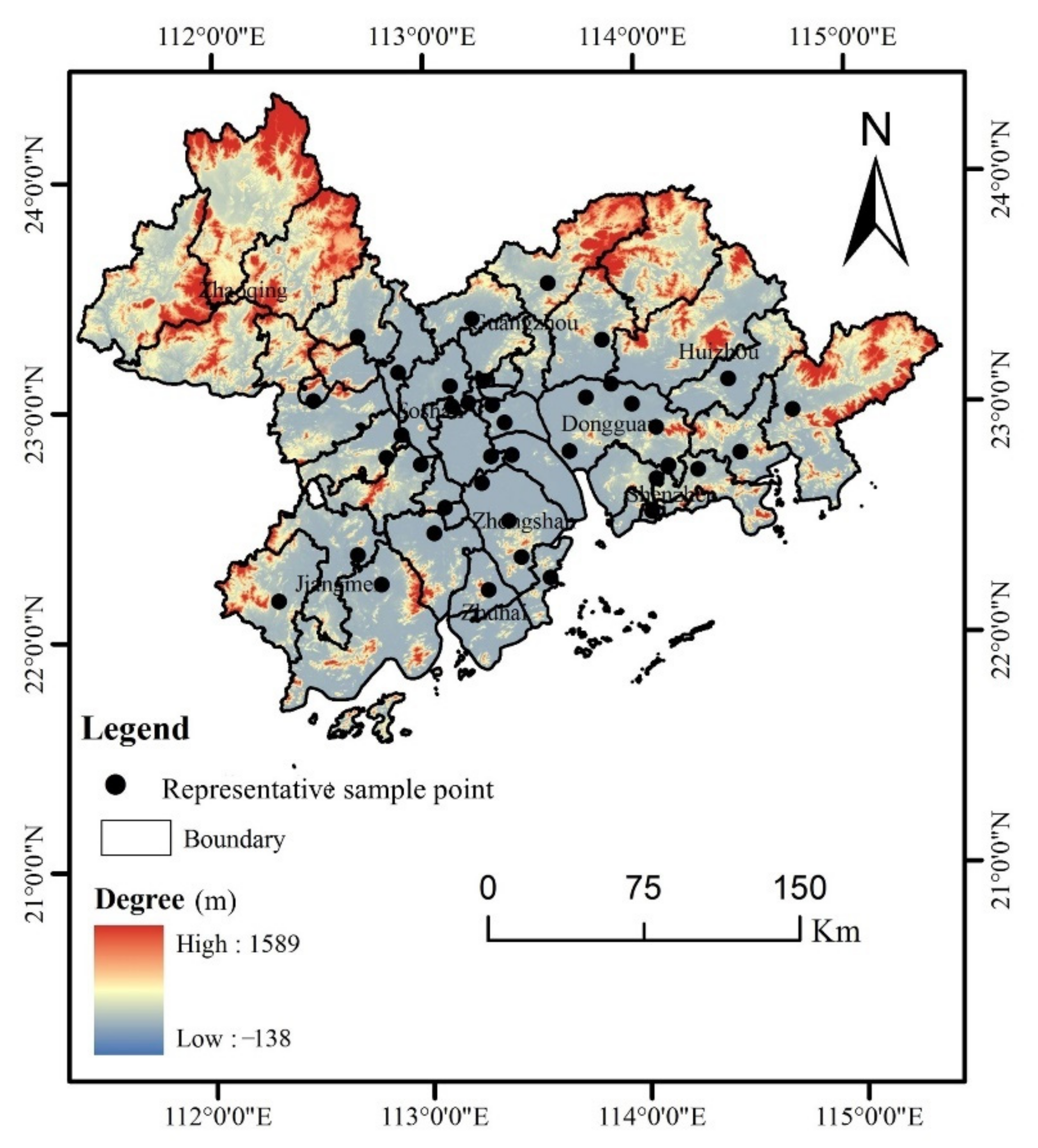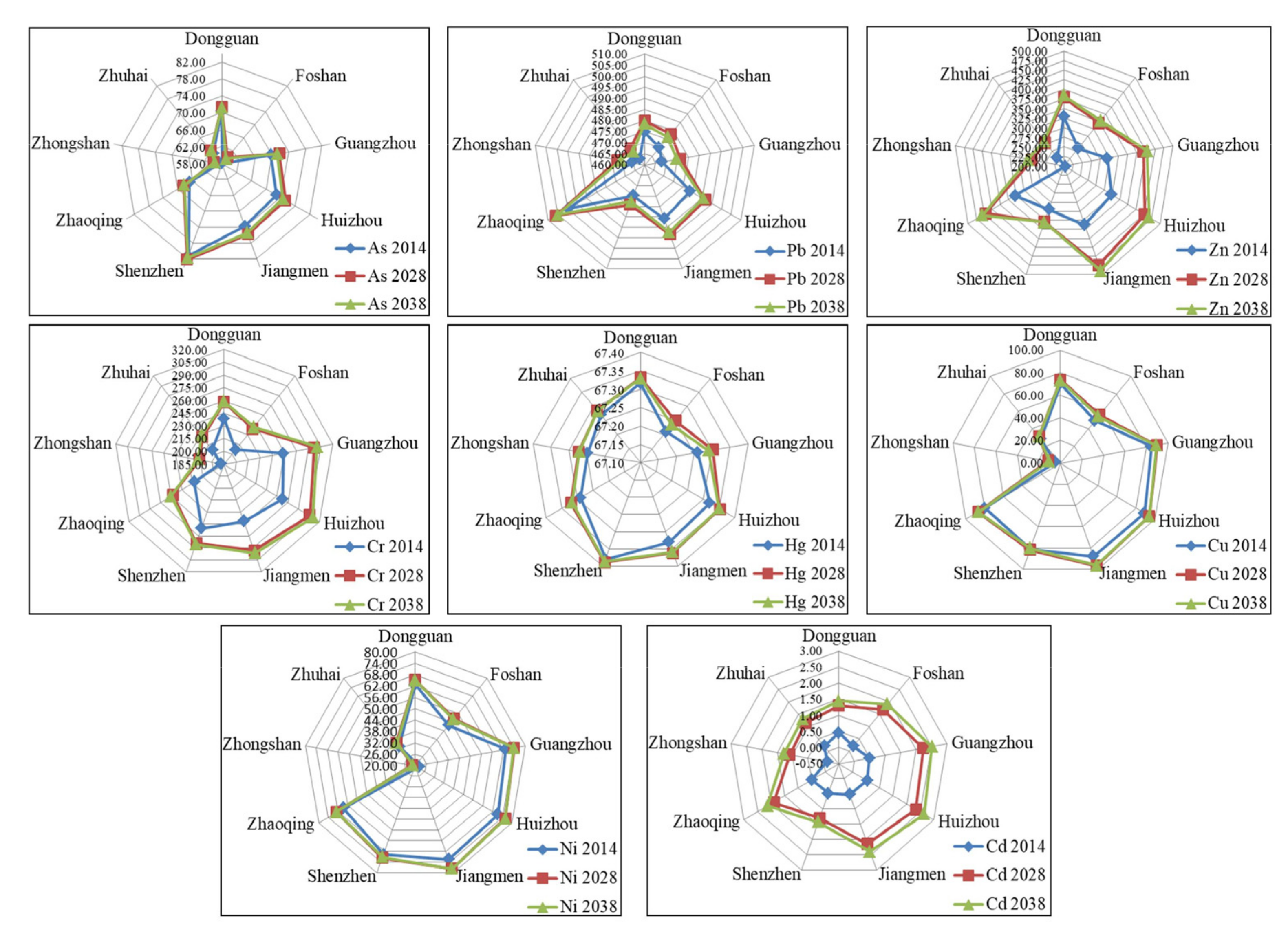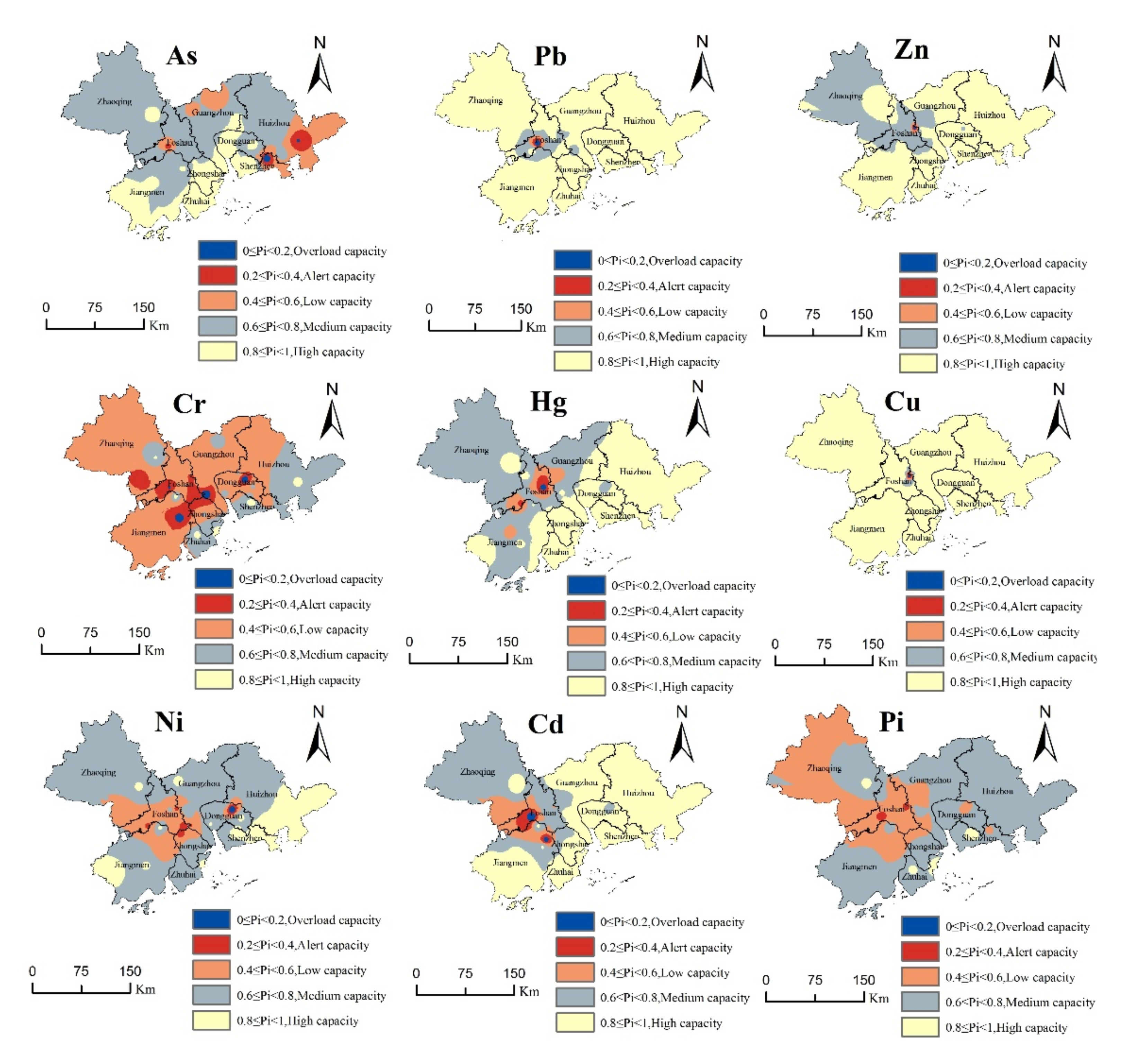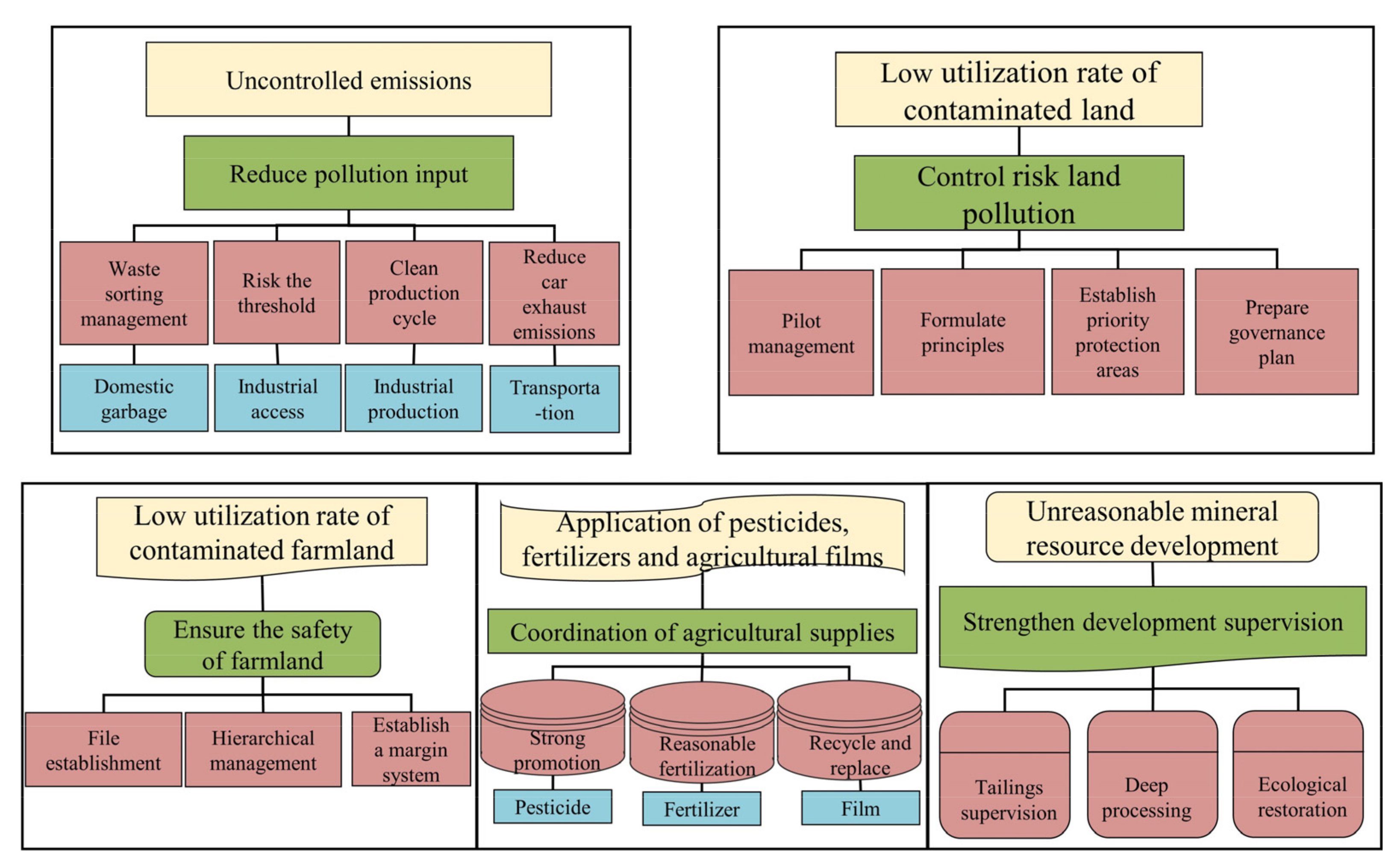Time-Space Simulation, Health Risk Warning and Policy Recommendations of Environmental Capacity for Heavy Metals in the Pearl River Basin, China
Abstract
:1. Introduction
2. Materials and Methods
2.1. Study Area
2.2. Sample Collection and Analysis
2.3. Methods
2.3.1. Spatial Analysis Method
2.3.2. Linear Model of Material Balance
2.3.3. Environmental Capacity Assessment Model
3. Results and Discussion
3.1. Soil Heavy Metal Environmental Capacity
3.1.1. Current Situation of the Environmental Capacity
3.1.2. Spatial Distribution of the Residual Capacity
3.1.3. Prediction of the Environmental Capacity
3.2. Evaluation and Health Risk Warning of the Heavy Metal Environmental Capacity
3.3. Suggestions on the Implementation of the “Soil Safety”
3.3.1. Reducing the Input of the Polluting Raw Materials
3.3.2. Managing and Controlling the Risks of Contaminated Lands
3.3.3. Ensuring the Safe Management of Cultivated Lands
3.3.4. To Co-Ordinate the Use of Agricultural Materials
3.3.5. Strengthening the Supervision of Mineral Development
4. Conclusions
Author Contributions
Funding
Institutional Review Board Statement
Informed Consent Statement
Data Availability Statement
Acknowledgments
Conflicts of Interest
References
- Jin, Y.; O’Connor, D.; Ok, Y.; Tsang, D.; Liu, A.; Hou, D. Assessment of sources of heavy metals in soil and dust at children’s playgrounds in Beijing using GIS and multivariate statistical analysis. Environ. Int. 2019, 124, 320–328. [Google Scholar] [CrossRef] [PubMed]
- Li, X.; Liu, L.; Wang, Y.; Luo, G.; Chen, X.; Yang, X.; Hall, M.; Guo, R.; Wang, H.; Cui, J.; et al. Heavy metal contamination of urban soil in an old industrial city (Shenyang) in Northeast China. Geoderma 2013, 192, 50–58. [Google Scholar] [CrossRef]
- Niu, F.; Feng, Z.; Liu, H. Evaluation of resources environmental carrying capacity and its application in industrial restructuring in Tibet, China. Acta Geo. Sin. 2019, 74, 8. [Google Scholar]
- Dong, R.; Jia, Z.; Li, S. Risk assessment and sources identification of soil heavy metals in a typical county of Chongqing Municipality, Southwest China. Process Saf. Environ. Protect. 2018, 113, 275–281. [Google Scholar] [CrossRef]
- Lv, Y.; Xie, L.; Zhu, W.; Zhou, Y.; Hua, S. Risk prediction of heavy metals in farmland soil based on environmental capacity case study of the county scale in northern Zhejiang province. Resour. Environ. Yangtze Basin 2020, 29, 1. [Google Scholar]
- Lü, H.; Mo, C.; Zhao, H.; Xiang, L.; Katsoyiannis, A.; Li, Y.; Cai, Q.; Wong, M. Soil contamination and sources of phthalates and its health risk in China: A review. Environ. Res. 2018, 164, 417–429. [Google Scholar] [CrossRef]
- Fang, C.; Wang, Z.; Liu, H. Exploration on the theoretical basis and evaluation plan of beautiful China construction. Acta Geogr. Sinica. 2019, 74, 4. [Google Scholar]
- The People’s Republic of China. Soil Pollution Prevention and Control Action Plan; The State Council of the People’s Republic of China: Beijing, China, 2016. [Google Scholar]
- Wang, W.; Lai, Y.; Ma, Y.; Liu, Z.; Wang, S.; Hong, C. Heavy metal contamination of urban topsoil in a petrochemical industrial city in Xinjiang, China. J. Arid Land 2016, 8, 871–880. [Google Scholar] [CrossRef] [Green Version]
- Guo, Y.; Sun, X.; Zhang, S.; Yu, G.; Tang, Z.; Liu, Z.; Xue, G.; Gao, P. Pollution characteristics, source analysis and potential ecological risk assessment of heavy metals in soils surrounding a municipal solid waste incineration plant in Shanghai. Environ. Sc. 2017, 38, 12. [Google Scholar]
- Li, X.; Cundy, A.; Chen, W.; Liu, R.; Lv, S. Dynamic capacity modelling of soil environment carrying capacity, and developing a soil quality early warning framework for development land in China. J. Clean. Prod. 2020, 257, 120450. [Google Scholar] [CrossRef]
- Zhang, K.; Yang, J.; Ji, Y.; Xia, Y. Spatiotemporal simulation and predication of heavy metal(loid) concentrations in coal chemical industrial areas with a soil environmental capacity model. Int. J. Coal Sci. Technol. 2018, 5, 508–518. [Google Scholar] [CrossRef] [Green Version]
- Xia, Z. Factors affecting regional differentiation of critical levels and environmental capacities of some heavy metals in main soil types of China. Acta Pedol. Sin. 1994, 31, 2. [Google Scholar]
- Hu, W.; Zhang, Y.; Huang, B.; Teng, Y. Soil environmental quality in greenhouse vegetable production systems in eastern China: Current status and management strategies. Chemosphere 2017, 170, 183–195. [Google Scholar] [CrossRef] [PubMed]
- Sun, L.; Guo, D.; Liu, K.; Meng, H.; Zheng, Y.; Yuan, F.; Zhu, G. Levels, sources, and spatial distribution of heavy metals in soils from a typical coal industrial city of Tangshan, China. Catena 2019, 175, 101–109. [Google Scholar] [CrossRef]
- Zeng, S.; Ma, J.; Yang, Y.; Zhang, S.; Liu, G.; Chen, F. Spatial assessment of farmland soil pollution and its potential human health risks in China. Sci. Total Environ. 2019, 687, 642–653. [Google Scholar] [CrossRef] [PubMed]
- Ma, H.; Yang, X.; Lv, G. Tendency prediction about soil environmental capacity of heavy metals in Jinghe county in Recent 100 Years. Techno Xinjiang Agric. Sci. 2016, 53, 1521–1532. [Google Scholar]
- Eli, A.; Eziz, M.; Jin, W.; Li, X. Environmental capacity of heavy metals in farmland soils in Yanqi Basin, Xingjiang. Environ. Eng. 2020, 38, 3. [Google Scholar]
- Fu, C.; Wang, W.; Pan, J.; Lu, H.; Liao, Q. Research of heavy metal environmental capacity in lishui district, Nanjing. Chinese J. Soil Sci. 2014, 45, 734–742. [Google Scholar]
- Chen, J.; Bi, J.; Wu, J.; Yang, G. Prediction of the trend for soil pollution of heavy metals in soils at Huzhou and evaluation of the environmental capacity. Earth Environ. 2011, 39, 4. [Google Scholar]
- Xu, F.; Liang, H.; Fan, J.; Chen, W. Evaluation of soil heavy metal environmental capacity of agricultural land in Fuzhou area. Safety Environ. Eng. 2009, 16, 4. [Google Scholar]
- Qin, G.; Zhang, P.; Hou, X.; Wu, S.; Wang, Y. Risk assessment for oil leakage under the common threat of multiple natural hazards. Environ. Sci. Pollut. Res. 2020, 27, 16507–16520. [Google Scholar] [CrossRef] [PubMed]
- Li, T.; Liu, Y.; Li, S.; Liu, Y.; Xie, Y. Soil Pollution Management in China: A Brief Introduction. Sustainability 2019, 11, 556. [Google Scholar] [CrossRef] [Green Version]
- Liu, C.; Lu, L.; Huang, T.; Huang, Y.; Ding, L.; Zhao, W. The distribution and health risk assessment of metals in soils in the vicinity of industrial sites in Dongguan, China. Int. J. Environ. Res. Public Health 2016, 13, 832. [Google Scholar] [CrossRef] [PubMed] [Green Version]
- Liu, Y.; Cao, X.; Xu, J.; Li, T. Influence of traffic accessibility on land use based on Landsat imagery and internet map: A case study of the Pearl River Delta urban agglomeration. PLoS ONE 2019, 14, 224136. [Google Scholar] [CrossRef] [PubMed]
- Zhou, X.; Wang, X. Impact of industrial activities on heavy metal contamination in soils in three major urban agglomerations of China. J. Clean. Prod. 2019, 230, 1–10. [Google Scholar] [CrossRef]
- HJ/T 166–2004; General Administration of Environmental Protection of the People’s Republic of China. Technical Specification for Soil Environmental Monitoring. China Standard Press: Beijing, China, 2004.
- Guangdong Provincial Bureau of Quality and Technical Supervision. Risk Screening Values for Soil Heavy Metal, The Pearl River Delta Area; Guangdong Provincial Bureau of Quality and Technical Supervision: Guangzhou, China, 2014; pp. 16–17.
- GB15618-2018; State Administration of Market Supervision and Administration of Ministry of Ecological Environment. Soil Environmental Quality Soil Pollution Risk Control Standard for Agricultural Land (for Trial Implementation). China Standard Press: Beijing, China, 2018.
- GB15618-1995; State Administration of Market Supervision and Administration of Ministry of Ecological Environment. Soil Environmental Quality Soil Pollution Risk Control Standard for Agricultural Land. China Standard Press: Beijing, China, 1995.
- Liu, Z.; Yu, X.; Jia, L.; Wang, Y.; Song, Y.; Meng, H. The influence of distance weight on the inverse distance weighted method for ore-grade estimation. Sci. Rep. 2021, 11, 2689. [Google Scholar] [CrossRef]
- Marhaba, T.; Mamattursun, E.; Aynur, M.; Wang, W. Evaluation and Prediction of Environmental Capacities of Heavy Metals in Vineyard Soils in the Turpan Basin. Earth Environ. 2020, 48, 584–592. [Google Scholar]
- Pan, Y.; Ding, L.; Xie, S.; Zeng, M.; Zhang, J.; Peng, H. Spatiotemporal simulation, early warning, and policy recommendations of the soil heavy metal environmental capacity of the agricultural land in a typical industrial city in China: Case of Zhongshan City. J. Clean. Prod. 2021, 285, 124849. [Google Scholar] [CrossRef]
- Meng, W.; Wang, Z.; Hu, B.; Wang, Z.; Li, H.; Goodman, R. Heavy metals in soil and plants after long-term sewage irrigation at Tianjin China: A case study assessment. Agric. Water Manag. 2016, 171, 153–161. [Google Scholar] [CrossRef]
- Pan, Y.; Peng, H.; Xie, X.; Zeng, M.; Huang, C. Eight elements in soils from a typical light industrial city, China: Spatial distribution, ecological assessment, and the source apportionment. Int. J. Environ. Res. Public Health 2019, 16, 2591. [Google Scholar] [CrossRef] [Green Version]
- Lu, A.; Li, B.; Li, J.; Chen, W.; Xu, L. Heavy metals in paddy soil-rice systems of industrial and township areas from subtropical China: Levels, transfer, and health risks. J. Geochem. Explor. 2018, 194, 210–217. [Google Scholar] [CrossRef]
- Chen, Y.; Huang, H.; Ding, Y.; Chen, W.; Luo, J.; Li, H.; Wu, J.; Chen, W.; Qi, S. Trace metals in aquatic environments of a mangrove ecosystem in Nansha, Guangzhou, South China: Pollution status, sources, and ecological risk assessment. Environ. Monit. Assess. 2019, 191, 629. [Google Scholar] [CrossRef] [PubMed]
- National Development and Reform Commission. Circular on issuing the Evaluation Index System and Implementation Plan for the Construction of Beautiful China; The State Council of the People’s Republic of China: Bejing, China, 2020; p. 296.
- Wang, S.; Cai, L.; Wen, H.; Luo, J.; Wang, Q.; Liu, X. Spatial distribution, and source apportionment of heavy metals in soil from a typical county-level city of Guangdong Province, China. Sci. Total Environ. 2019, 655, 92–101. [Google Scholar] [CrossRef] [PubMed]
- Wang, X.; Zeng, X.; Liu, C.; Li, F.; Xu, X.; Lv, Y. Heavy metal contaminations in soil-rice system: Source identification in relation to a sulfur-rich coal burning power plant in Northern Guangdong Province, China. Environ. Monit. Assess. 2016, 188, 460. [Google Scholar] [CrossRef]
- Wang, Y.; Duan, X.; Wang, L. Spatial distribution, and source analysis of heavy metals in soils influenced by industrial enterprise distribution: Case study in Jiangsu province. Sci. Total Environ. 2020, 710, 134953. [Google Scholar] [CrossRef]
- Hu, Y.; Qi, S.; Wu, C.; Ke, Y.; Chen, J.; Chen, W.; Gong, X. Preliminary assessment of heavy metal contamination in surface water and sediments from Honghu Lake, East Central China. Front. Earth Sci. 2012, 6, 39–47. [Google Scholar] [CrossRef]
- Ye, C.; Butler, O.; Du, M.; Liu, W.; Zhang, Q. Spatial-temporal dynamics, drivers and potential sources of heavy metal pollution in riparian soils along a 600 kilometer stream gradient in Central China. Sci. Total Environ. 2019, 651, 1935–1945. [Google Scholar] [CrossRef]
- Zheng, H.; Zhang, Z.; Xing, X.; Hu, T.; Qu, C.; Chen, W.; Zhang, J. Potentially Toxic Metals in Soil and Dominant Plants from Tonglushan Cu–Fe Deposit, Central China. Bull. Environ. Contam. Toxicol. 2019, 102, 92–97. [Google Scholar] [CrossRef]
- Zhao, K.; Zhang, L.; Dong, J.; Wu, J.; Ye, Z.; Zhao, W.; Ding, L.; Fu, W. Risk assessment, spatial patterns and source apportionment of soil heavy metals in a typical Chinese hickory plantation region of southeastern China. Geoderma 2020, 360, 114011. [Google Scholar] [CrossRef]





| Element | Background Value | Reference Value |
|---|---|---|
| As | 25.00 | 40.00 |
| Pb | 60.00 | 250.00 |
| Zn | 97.00 | 200.00 |
| Cr | 77.00 | 150.00 |
| Hg | 0.13 | 30.00 |
| Cu | 32.00 | 50.00 |
| Ni | 28.00 | 40.00 |
| Cd | 0.11 | 0.30 |
| Level | Pi | Capacity Level | Health Risk Level |
|---|---|---|---|
| Ⅰ | 0 ≤ Pi < 0.2 | Overload capacity | Extreme risk |
| Ⅱ | 0.2 ≤ Pi < 0.4 | Alert capacity | Severe risk |
| Ⅲ | 0.4 ≤ Pi < 0.6 | Low capacity | Moderate risk |
| Ⅳ | 0.6 ≤ Pi < 0.8 | Medium capacity | Mild risk |
| Ⅴ | 0.8 ≤ Pi < 1 | High capacity | No risk |
| City | As | Pb | Zn | Cr | Hg | Cu | Ni | Cd |
|---|---|---|---|---|---|---|---|---|
| Dongguan | 70.42 | 474.75 | 328.50 | 238.50 | 67.32 | 69.98 | 62.78 | 0.46 |
| Foshan | 58.05 | 470.25 | 261.00 | 207.00 | 67.21 | 49.05 | 47.92 | 0.21 |
| Guangzhou | 69.75 | 468.00 | 319.50 | 258.75 | 67.26 | 84.60 | 69.30 | 0.49 |
| Huizhou | 72.90 | 483.75 | 348.75 | 267.75 | 67.32 | 88.65 | 71.32 | 0.55 |
| Jiangmen | 73.80 | 486.00 | 362.25 | 256.50 | 67.33 | 87.98 | 72.45 | 0.52 |
| Shenzhen | 81.22 | 474.75 | 319.50 | 265.50 | 67.38 | 81.00 | 69.75 | 0.49 |
| Zhaoqing | 66.82 | 499.50 | 353.25 | 227.25 | 67.29 | 79.88 | 64.58 | 0.49 |
| Zhongshan | 58.50 | 465.75 | 195.75 | 189.00 | 67.25 | 4.95 | 17.78 | −0.12 |
| Zhuhai | 61.62 | 463.50 | 229.50 | 207.00 | 67.27 | 27.90 | 33.30 | 0.21 |
| Urban Agglomeration Area | City | As | Pb | Zn | Cr | Hg | Cu | Ni | Cd | References |
|---|---|---|---|---|---|---|---|---|---|---|
| The Pearl River Basin | Dongguan | 69.76 | 457.48 | 291.55 | 232.88 | 67.24 | 53.38 | 59.41 | 0.38 | This study |
| Foshan | 41.66 | 334.62 | 17.65 | 189.77 | 66.51 | −3.79 | 35.84 | 0.56 | ||
| Guangzhou | 43.79 | 413.21 | 214.85 | 196.04 | 66.96 | 39.32 | 43.51 | 0.13 | ||
| Huizhou | 28.80 | 440.33 | 264.08 | 252.68 | 67.17 | 69.68 | 65.63 | 0.38 | ||
| Jiangmen | 57.79 | 449.63 | 282.49 | 205.46 | 67.05 | 46.58 | 53.44 | 0.00 | ||
| Shenzhen | 37.70 | 452.31 | 280.75 | 239.91 | 67.37 | 58.39 | 65.76 | 0.41 | ||
| Zhaoqing | 65.14 | 468.46 | 212.40 | 224.11 | 67.14 | 44.33 | 50.29 | 0.05 | ||
| Zhongshan | 65.48 | 439.05 | 194.03 | 216.15 | 67.19 | 13.34 | 42.75 | 0.03 | ||
| Zhuhai | 76.84 | 400.84 | 288.12 | 277.99 | 67.24 | 67.39 | 60.98 | 0.34 | ||
| The Yangtze River Basin | Nanjing | 42.55 | 493.58 | 317.24 | 400.57 | 0.51 | 52.97 | 31.08 | 0.46 | [19] |
| Huzhou | 21.80 | 151.00 | 486.00 | 85.70 | 1.92 | 173.00 | 61.20 | 1.70 | [20] |
| Urban Agglomeration Area | City | Pi | Capacity Level | Risk Level |
|---|---|---|---|---|
| The Pearl River Basin | Dongguan | 0.76 | Medium capacity | Mild risk |
| Foshan | 0.44 | Low capacity | Moderate risk | |
| Guangzhou | 0.60 | Medium capacity | Mild risk | |
| Huizhou | 0.71 | Medium capacity | Mild risk | |
| Jiangmen | 0.63 | Medium capacity | Mild risk | |
| Shenzhen | 0.74 | Medium capacity | Mild risk | |
| Zhaoqing | 0.70 | Medium capacity | Mild risk | |
| Zhongshan | 0.67 | Medium capacity | Mild risk | |
| Zhuhai | 0.87 | Medium capacity | Mild risk | |
| The Yangtze River Basin | Nanjing | 0.91 | High Capacity | No risk |
| Huzhou | 0.88 | High Capacity | No risk |
Publisher’s Note: MDPI stays neutral with regard to jurisdictional claims in published maps and institutional affiliations. |
© 2022 by the authors. Licensee MDPI, Basel, Switzerland. This article is an open access article distributed under the terms and conditions of the Creative Commons Attribution (CC BY) license (https://creativecommons.org/licenses/by/4.0/).
Share and Cite
Liang, F.; Pan, Y.; Peng, H.; Zeng, M.; Huang, C. Time-Space Simulation, Health Risk Warning and Policy Recommendations of Environmental Capacity for Heavy Metals in the Pearl River Basin, China. Int. J. Environ. Res. Public Health 2022, 19, 4694. https://doi.org/10.3390/ijerph19084694
Liang F, Pan Y, Peng H, Zeng M, Huang C. Time-Space Simulation, Health Risk Warning and Policy Recommendations of Environmental Capacity for Heavy Metals in the Pearl River Basin, China. International Journal of Environmental Research and Public Health. 2022; 19(8):4694. https://doi.org/10.3390/ijerph19084694
Chicago/Turabian StyleLiang, Feng, Yujie Pan, Hongxia Peng, Min Zeng, and Changsheng Huang. 2022. "Time-Space Simulation, Health Risk Warning and Policy Recommendations of Environmental Capacity for Heavy Metals in the Pearl River Basin, China" International Journal of Environmental Research and Public Health 19, no. 8: 4694. https://doi.org/10.3390/ijerph19084694
APA StyleLiang, F., Pan, Y., Peng, H., Zeng, M., & Huang, C. (2022). Time-Space Simulation, Health Risk Warning and Policy Recommendations of Environmental Capacity for Heavy Metals in the Pearl River Basin, China. International Journal of Environmental Research and Public Health, 19(8), 4694. https://doi.org/10.3390/ijerph19084694





